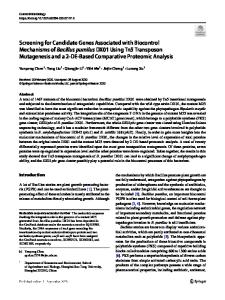Characterization of a Protease Hyper-Productive Mutant of Bacillus pumilus by Comparative Genomic and Transcriptomic Ana
- PDF / 1,939,493 Bytes
- 11 Pages / 595.276 x 790.866 pts Page_size
- 45 Downloads / 321 Views
Characterization of a Protease Hyper‑Productive Mutant of Bacillus pumilus by Comparative Genomic and Transcriptomic Analysis Yong‑Cheng Liu1 · Lin‑Li Han1 · Tian‑Yu Chen1 · Yan‑Bing Lu1 · Hong Feng1 Received: 21 February 2020 / Accepted: 28 July 2020 © Springer Science+Business Media, LLC, part of Springer Nature 2020
Abstract Bacillus pumilus BA06 has great potential for the production of alkaline proteases. To improve the protease yield, classical mutagenesis to combine the physical and chemical mutagens was performed to obtain a protease hyper-productive mutant SCU11. The full genome sequences of BA06 and SCU11 strains were assembled through DNA sequencing using the PacBio sequencing platform. By comparative genomics analysis, 147 SNPs and 15 InDels were found between these two genomes, which lead to alternation of coding sequence in 15 genes. Noticeable, the gene (kinA) encoding sporulation kinase A is interrupted by introducing a stop codon in its coding region in BA06. Interestedly, this gene is reversely corrected in SCU11. Furthermore, comparative transcriptome analysis revealed that kinA and two positive regulatory genes (DegU and Spo0A) were upregulated in transcription in SCU11. In terms of the transcriptional data, upregulation of a phosphorylation cascade starting with KinA may enhance Spo0A phosphorylation, and thus activate expression of the gene aprE (encoding major extracellular protease) through repression of AbrB (a repressor of aprE) and activation of SinI, an antagonist of SinR (a repressor of aprE). In addition, the other genes involved in various metabolic pathways, especially of membrane transport and sporulation, were altered in transcription between these two strains. Conclusively, our transcriptome data suggested that upregulation degU and spo0A, as well as kinA, may at least partially contribute to the high production of alkaline protease in SCU11.
Introduction Bacillus pumilus is a widely distributed Gram-positive and rod-shaped bacterium that can form endospores in face of adversity. It belongs to the B. subtilis group [1], and can produce and secret a variety of enzymes, such as alkaline serine protease [2–4], xylanase [5], and pectate lyase [6], which could be applied to various industries [7, 8]. Therefore, B. pumilus has been received great attention as a potential industrial strain [9, 10].
Electronic supplementary material The online version of this article (https://doi.org/10.1007/s00284-020-02154-5) contains supplementary material, which is available to authorized users. * Hong Feng [email protected] 1
College of Life Sciences, Sichuan Key Laboratory of Molecular Biology and Biotechnology, Key Laboratory of Bio‑Resources and Eco‑Environment, Ministry of Education, Sichuan University, Chengdu 610064, Sichuan, People’s Republic of China
The mutagenesis of microbial cells with chemical or physical mutagens has been applied to various microorganisms to improve production of various enzymes and other metabolites [11–13]. In commercial production of bacterial proteases,
Data Loading...











